Вы здесь
History Zharkent of mosque.
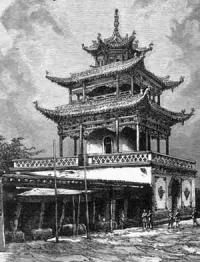
Architectural places of interest Zharkent.
"Do not let the shoes you put on dry out too much and do not forget the days gone by"
Inscription in Uyghur on the pediment above the entrance to the mosque.
Best New Almaty cultural tours.
In 1887, at one of the meetings of the Muslim community, it was decided to start collecting money for the construction of a mosque. The role of the main sponsor and organizer was taken on by the merchant of the first guild, Vali Akhun Yuldashev, who also made the main contribution.
To implement the plan, more than a hundred of the most skilled builders were gathered from all over the region. The mosque was built in 1895 with donations from Uyghurs who had migrated from Kulja. The construction and decorative design of the mosque was supervised by the architect Hon Pike (Mukan) "Don Fi", with the participation of folk craftsmen Hasan Imanov, Tair Ismailov, Nasretdin Kara, Abdukadyr, Ushurbaki, Zainutdin and others.
According to popular legend, the builder of the mosque, the Chinese architect Hon Pike, was executed upon his return to Beijing, since even in the Celestial Empire there was no mosque more beautiful than the one he built in Zharkent. In order to have complete unity of action between the multilingual builders and, perhaps, taking into account the biblical experience of erecting the high-rise Tower of Babel, the team acquired translators who spoke Chinese and several Turkic languages.
Judging by what happened, the builders acted more than in concert. Rumor has it that the Chinese architect had previously erected a beautiful structure in his homeland, and his creation was so much liked by those for whom it was intended that they began to fear that the master might create something similar elsewhere.
To prevent this from happening, the "grateful" admirers of his talent decided to take the architect's life. Hon Pik learned about the upcoming "reward" for his creative approach to the task entrusted to him. It was natural for him to want to get as far away from his jealous admirers as possible, and he had no choice but to appear before the eyes of the Zharkent people, who were anxious to find the architect. Later, he nevertheless returned to his homeland...
The temple was built from Tien Shan spruce, which is distinguished by its extraordinary strength and longevity. The logs were harvested in the Aksu and Ketmen Mountains. After thorough drying, the building parts were prepared from them. It is noteworthy that nails were not used during installation.
The frame of the building consists of 122 wooden pillars, which are connected by a system of beams and attachments. In 1892, the mosque was built. It amazed the residents of Zharkent with its original beauty and elegance. They had never seen such a work of art anywhere.
The architect took a lot from the traditional style of construction of similar buildings in Central Asia, and therefore the recognizable attributes of the building became a luxurious central arch, corner guldasta towers imitating minarets, domed ceilings and cartouches with epigraphic inscriptions.
And the entire structure bears the stamp of the architect's talent, his originality. He creatively used elements of Chinese architecture, giving the mosque some features of a Buddhist temple. The so-called hovering roof, with curved ends of the slope, and also a gallery with cylindrical columns without capitals, a large cornice surrounding the building, give it special elegance and lightness.
/Its main hall can accommodate about a thousand believers, in many ways makes a large number of wood carvings and bright polychrome paintings. Due to this, the surface of the arches and walls acquires an openwork lightness and artistic sophistication.
The ornament is dominated by plant motifs, but there are also images of birds, fish, real and fantastic animals. The rich imagination of the architect made the building a genuine work of art. "Do not overdry the shoes you put on and do not forget the days gone by" - says the inscription, skillfully written by calligraphers in a flexible and therefore seemingly airy ligature in the Uyghur language on the pediment above the entrance to the mosque.
This unique structure was built through the efforts of the 1st guild merchant Velivai-akhun - it is his words that are imprinted on the pediment. The construction of the mosque began back in 1880, and the merchant spent a gigantic sum for its construction at that time - 300 thousand rubles in gold.
The mosque turned out to be so exotic because it was built by the Chinese architect Hong-Ni - he built it as best he could. In order to make the foundation for the temple being built, clay was brought here, which was kneaded by the entire population of Zharkent and the surrounding villages.
And only after the clay had acquired the hardness of stone, they began to build a mosque on it. The carefully painted pagodas leave an indelible impression. The unusually bright colors look gaudy, but, skillfully intertwined in a bizarre ornament, they strangely give the temple solemnity and beauty.
Over time, however, they have faded considerably and now look like patina on the products of ancient masters. There are only three such mosques in the world. One of them is in Ghulja, the second in Shanghai and the third here. The central structure, where prayers were offered, evokes particular delight.
The meticulousness and skill of the great architect who created the minbar - the pulpit for the preacher - amazes with the thoroughness of its decoration, each element of the arabesques decorating it - a stylized plant pattern. Numerous panels, patterned ganch carving, creating the illusion of lace woven from sea foam, are amazing.
The architecture of the building structure and the decor of the monument reflect a unique combination of forms from the Zailiysky region, Kazakhstan and Central Asia. The roof structure is interesting, consisting of a number of wooden elements - beams and special brackets called "dou" and "gun", allowing the cornices to be curved.
Creating the illusion of a "floating roof", the roof cornices are richly decorated with carved boards with bright polychrome colors. All wooden joints are made using original cuttings without the use of nails. The paintings of the mosque and the pagoda tower reflect magnificent examples of painting and ornamentation.
The monument features widely ganch carving, from ornamented belts to complex decorative panels and epigraphic cartouches - arabesques. Among the plant and geometric ornaments are images of animals, birds, and fish. The two-tiered pagoda tower is a collection of unique paintings, the motifs of which are taken from the surrounding nature: flowers, leaves, clouds, and many boards are covered with complex still lives and landscapes. Islamic schools were opened at the mosque, where children were taught by mullahs.
Next to the mosque stood the house of the "boy", Velivai-akhun Yuldashev himself. The length of the mosque is 54.5 meters, the width is 29 meters, the height of the tower - pagoda is 22 meters. The building was completely restored in Soviet times.
About a hundred people took part in the construction of the mosque - craftsmen and workers of different nationalities. A lot of earth was brought to the middle of the block, which was compacted and leveled for a long time, creating a powerful stylobate, on which they began to erect the building.
Huge wooden columns were raised with the help of several teams of oxen. The builders, performing this or that work, used pre-prepared standard parts of columns, beams, rafters, roof tiles, and, if necessary, made them themselves, taking into account the proportionality and shape.
In 1910, a strong earthquake occurred in Zharkent. Significant damage also occurred at the mosque portal: both decorative towers collapsed, the tops of the domes fell, and because of the through cracks that formed in the sails of the domes, the stairwells leading to the roof had to be closed, and access to the mosque through the main gate was terminated.
In 1948-1949, the first in-depth study of the mosque was conducted, as a result of which this outstanding architectural monument was taken under state protection. The main restoration work was carried out in 1975-1978. Upon completion, the museum of the architectural and artistic complex "Zharkent Mosque" was created here.
In 1965, a hurricane swept through Zharkent, but the building withstood this natural disaster. In different years, the building was used as warehouses and a grain storage facility, people lived in it, and every year it fell into disrepair. The first serious study of the mosque was carried out in 1969, when engineering surveys were carried out, and the features of building structures and decor were studied.
During the restoration work of 1975-1978, a decision was made to create an unusual museum for that time - the architectural and artistic complex "Zharkent Mosque". On March 24, 1978, the Chairman of the Council of Ministers of the Kazakh SSR B. Ashimov signed an order of the Council of Ministers of the Kazakh SSR on the opening of an architectural and artistic museum in the city of Panfilov (Zharkent).
The residents of Zharkent could have completely lost this ancient monument if the first secretary of the Central Committee of the Communist Party of the Republic Dinmukhamed Kunayev had not visited here in the late 70s. After this visit, restoration work began in the mosque, the monument was taken under state protection.
In 2001-2004, 26 million tenge were allocated for its partial repair. Their development allowed to bring the museum to a more or less divine appearance: partial repairs were carried out, the roof was renewed, the main portal was put in order.
Geographic coordinates of Zharkent mosque: N44°09'46 E80°00'01

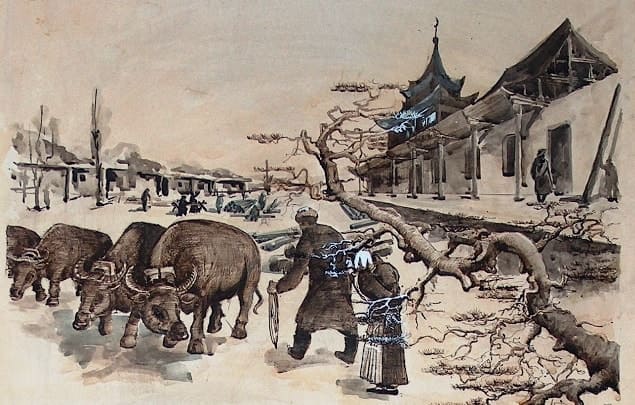
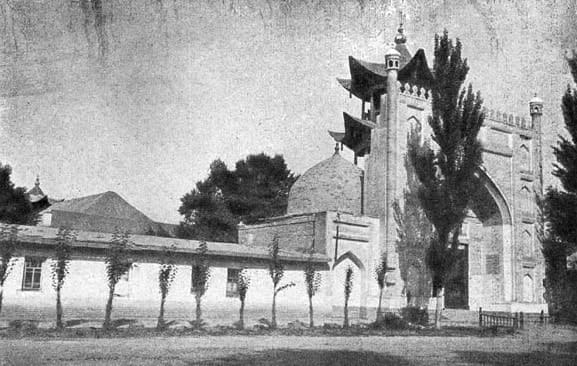
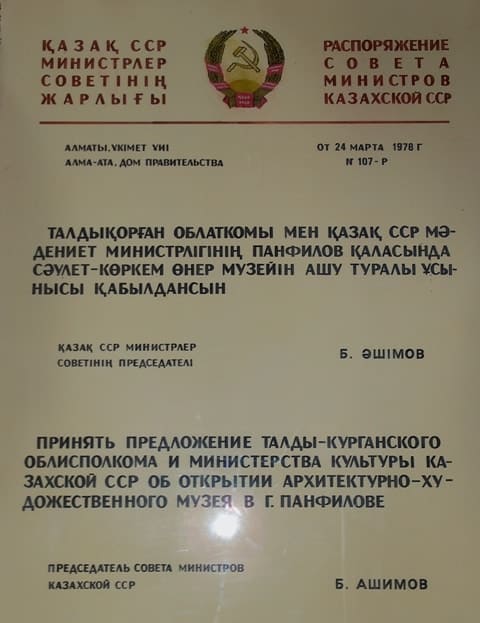
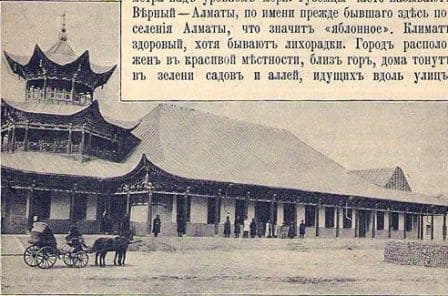
Authorship:
A small part of the information is used from the book "The City of Verny and Semirechensk Region" 2009, author A.G. Lukhtanov. Iskander Amanzhol. The other part of the information is collected from various sources by A. Petrov. Alexey Petrovsky. Kazakhstanskaya Pravda.







